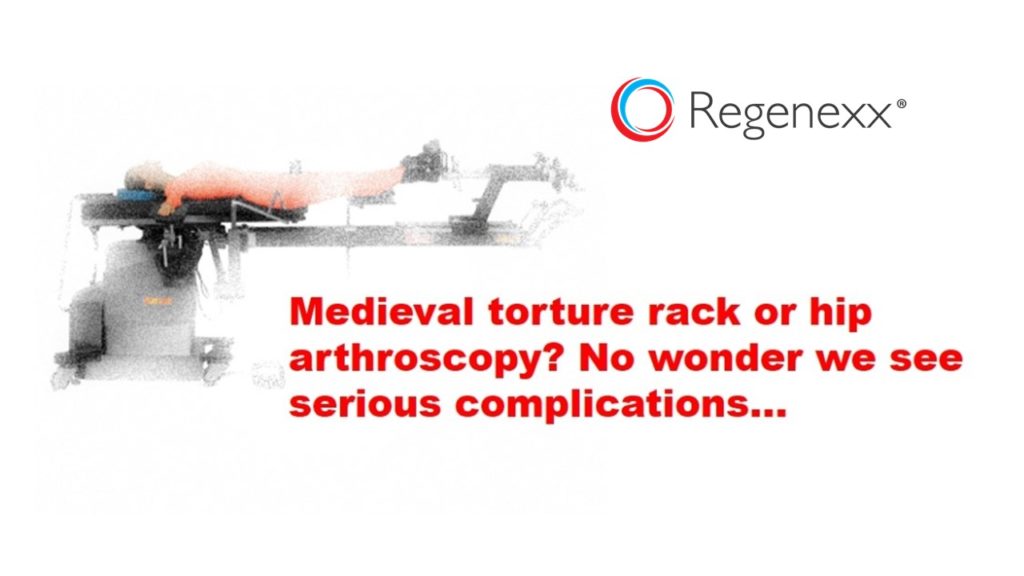My Hip Arthroscopy Blog: More Side Effects
While this is not specifically a hip arthroscopy blog, through the years I have discussed the many negative experiences my patients have had with the surgery. My first realization of the serious side effects of the procedure came back in 2008, when we borrowed a hip distraction unit form an orthopedic surgery practice to test how best to get stem cells into the arthritic part of the hip joint. What we found out about the side effects of hip arthroscopy was scary. This past week I spoke to a woman on the phone who has the complication we discovered and I asked her if I could share her story with my readers, as hip arthroscopy complications are rarely discussed.
Hip arthroscpy has been the single fastest growing type of orthopedic surgery of the last decade. Why? Prior to that, outside of a few procedures, hips couldn’t be operated without amputating and replacing the joint with a prostheses. The most common reasons why someone would undergo a hip arthroscopy surgery today are either a labral tear or impingement. The labrum is the lip around the socket where the ball of the femur inserts. This structure can become torn and degenerative. Impingement can happen when the bones of the joint become misshapen or the patient is born with a strangely shaped hip.
At first glance, hip arthroscopy surgery would seem to be just another modern medical miracle, but a closer inspection of the science behind these surgeries shows a different story. For example, many of the MRI abnormalities that are being operated are present in normal patients that have no hip pain. In addition, the outcomes of the procedures aren’t generally very good when any arthritis is present, which is a problem for many hip arthroscopy patients. In addition, we have no high level research that shows that this procedure is effective at all, a bar that other common procedures like meniscus surgery has failed to surmount. Then there are the many complications, not the least of which is the hip arthroscopy “portal syndrome”, a problem described first in this blog. However, one of the most serious complications is what we found during cadaver experiments and what my patient reported – ligamentum teres instability.
When we were trying to decide the best route to inject hips that got the stem cells in the area of the joint that needed the most help, we decided to try distraction. We borrowed a back up hip distraction unit that was being used by a local hip surgery practice. The device is used in all hip arthroscopy as there isn’t enough room in the normally very tight hip joint to allow the arthroscope to enter, so the device pulls the ball partially out of the socket. In our experiment we began pulling the hip at around less than half to a third of the weight that hip surgeons commonly use and what we injected promptly was sucked into the right region of the hip. We were pleasantly surprised until we tried to do a second injection. That’s when we realized that even our low weight pull had destroyed the internal stabilizing ligament of the hip called the ligamentum teres. Basically, each successive cadaver hip we tested was worthless after the first traction run. We were a bit stunned, as none of the surgeons who were performing these surgeries had ever mentioned this as a possible complication.
The patient I just spoke to about candidacy for a stem cell procedure underwent a hip arthroscopy surgery many years ago to treat a labral tear. Many years later and after many different types of therapy, she’s never recovered from the initial procedure. Right after the surgery, the surgeon had found that the ligamentum teres was torn on a post-operative MRI. This is a central ligament that comes from the apex of the ball and attaches into the socket to keep the two together. It acts with the labrum to help passively stabilize the hip. My patient now finds herself with a worsening hip, despite all of her best efforts, because the hip is unstable and as the joint moves too much, this extra motion causes more wear and tear arthritis.
The upshot? As we found way back in 2008, hip arthroscopy side effects can be ugly. Not the least of which is the fact that the distraction used to get the arthroscope in the joint may damage the important ligaments meant to stabilize the joint. These side effects and the unclear clinical outcomes of hip arthroscopy have led us to avoid sending patients for this surgery, instead focusing on precise injections of platelets and stem cells to help problems like labral tears. What can be done for this new patient? We will have to see if we can precisely target the deep ligamentum teres ligament to help fix what the arthroscopy damaged.

If you have questions or comments about this blog post, please email us at [email protected]
NOTE: This blog post provides general information to help the reader better understand regenerative medicine, musculoskeletal health, and related subjects. All content provided in this blog, website, or any linked materials, including text, graphics, images, patient profiles, outcomes, and information, are not intended and should not be considered or used as a substitute for medical advice, diagnosis, or treatment. Please always consult with a professional and certified healthcare provider to discuss if a treatment is right for you.

